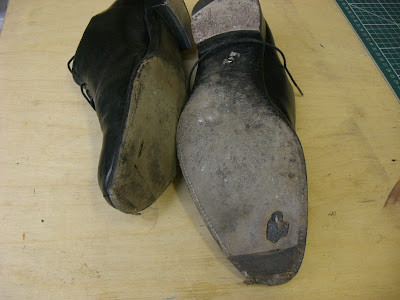2 weeks off and it takes a while for the head to get back into gear, but my first week back has been good.
Our carreducker bespoke shoemaking course starts on May 10th and The Other One is off to New York next Friday. How exciting. I am going the week after and am really looking forward to it. Should be fun.
We went to visit the Edward Green factory in Northampton this week. What a fantastic place. Having seen what they do, I can confidently say that they make the finest factory made shoes I have ever seen. Such attention to detail and a wonderful finish on the shoes.
Hilary Freeman, the MD, generously spent time showing us round, and what really impressed us was her willingness to invest in changes to production to achieve the best results without cutting corners. She obviously cares passionately about the quality of her product and does not stint on achieving this. Great to see this attitude (that we share wholeheartedly) in a production shoe.
This ethos really shows in the finished shoe, distinctly English and of a visibly superior quality.
We also appeared on the How to Spend It website this week, in an article about our outlet in Notting Hill, Wolf and badger. If you click through, please be patient as the luxury watch ad loads, it will go through to the page in time, honest! Great write up from the doyenne of luxury, now that's got to be good.
One great thing about bespoke shoes is that, because of the construction, they are completely repairable, so they will last you for years, a lifetime one might say. Just ask Prince Charles.
We recommend that you polish on a regular basis to protect the upper leather. If this dries out and cracks, it can be patched, but this looks a little unsightly. The best policy is to look after it. All the rest of the shoe, heels, soles etc, can be replaced.
We regularly get shoes back to repair, such as the following pair. They were in a bit of a sorry state, but we have brought them back to life, as good as new.



Notice the wear on the toe plates and how the sole has completely worn through - not good! With a resole like this, you must remove the heel; remove the old sole; stitch a new one on; rebuild the heel; set the edges; and finish the shoe again. It is a major repair and is about two thirds of making a new shoe from scratch - a lot of work.
The first thing to do is to put the lasts back into the shoes. Remove the cone and get the toe in as far as you can. At the heel, you will have to insert 3 knives (sharp end up). These act as a an aid to slide the last into the shoe. Hold the knives while hammering the last down. It should slide in, and as it passes the top edge of the shoe, slide the knives out. Then replace the cone. Forgive the blurred pic, but I had my hands full!

With the last in place, it is time to remove the heel. The top piece will be replaced, but the heel lifts are saved and re-used so that you don't have to start from scratch when you rebuild the heel. Gently prise them away, and remove them, being careful not to damage them. Number them and keep them in a safe place.


When you get to the split lift, again, prise it up, being careful not to damage it. Remove the nails except the last 3 at the back. Lift both sides and nail them down at the back to keep them out of the way.

With the heel removed, it's time to remove the sole. Start at the toe and cut the stitches so that it 'peels' back towards the heel. This can be a painful process as it is all your previous good work being destroyed. I think this is why I don't enjoy repairs, the undoing of previous hard work. But it has to be done.

When you get to the heel area, you must cut the sole at an angle so that you can seamlessly splice the new sole onto the old one.

The next stage is preparing the sole, in preparation for stitching it on. I will cover that next week.
So, in the meantime, happy shoemaking.